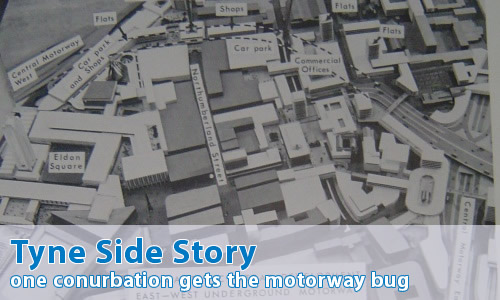Tyne Side Story
Part Two - The Death of a Plan (1970-1975)
What happened next?
Unlike the previous 10 year period, work started, or at least preparation work did...
In 1972, construction started on the Central Motorway East, including the link to what was planned to become the Coast Road Motorway.
Also in 1972, the local authorities across the region came together to produce the "Tyne/Wear Plan - Transport Plan for the 1980s".
This document, in common with others produced in most major conurbations at the time attempted to look forward in time and produce plans that would cover the following twenty to thirty years. These plans not only included road proposals, but also massive public transport improvements, such as extra rail lines and so on.
All was well for a while, the Plan was approved, and work began on those schemes identified as being within Stage One.
It didn't last long.
Why not?
Well, the Local Government Act 1972 came into force in 1974 - and the local councils lost their status as Highways Authorities - which was passed to the new Tyne and Wear County Council.
The new council took another look at the Transport Plan, and found that it was behind schedule. In fact, only around 30% of the Stage One items had been completed, even though the entire stage was supposed to be completed by 1974. The second phase was to have covered 1975-1980 and out of thirteen schemes in this phase:
"only four have any prospect of being in a state of preparedness for construction during this period"
That doesn't sound too good.
Indeed it doesn't.
Worse was to come, in the shape of Central Government grants for transport.
The DoE assessed that the total amount of grant finance available nationally for 1975 and beyond as £284m, and T&WCC's share on the basis of population was assessed as being between £18m and £21m. The County Council asked for a total of £39m, of which £33m was granted.
The County can, therefore consider itself to have received more than its share of the national cake. The reason for this is the commitment to the Metro whose importance is accepted by Central Government. Whilst the Metro is under construction it is to be expected that the DoE will wish to see other expenditure kept to a minimum, and indeed rate borne finance will also impose a limitation on the level of expenditure acceptable to the Council. Thus in the period up to 1981 when the Metro is complete a comparitively low level of capital expenditure on major highway works can be envisaged.
Effectively, this meant that the entire highways plan, and all other public transport improvements were sacrificed on the altar of the Metro.
TWCC then agreed an "Interim Review of Road Proposals" on 31 July 1975 (prepared April 1975). This review had three categories:
- Category 1: "Schemes that are allowed to proceed"
- Category 2: "Those road schemes for which a line would continue to be protected"
- Category 3: "Schemes not to be proceeded with".
I think I can guess which categories the entire motorway network fell in.
It's not difficult, is it.
So, only three years after it was confirmed to proceed at "full speed ahead", the entire plan came crashing down. However, as with all unbuilt urban motorway plans, the fun today is spotting small built sections of the original plan or finding where smaller roads have been built into a gap left for a planned larger road.

